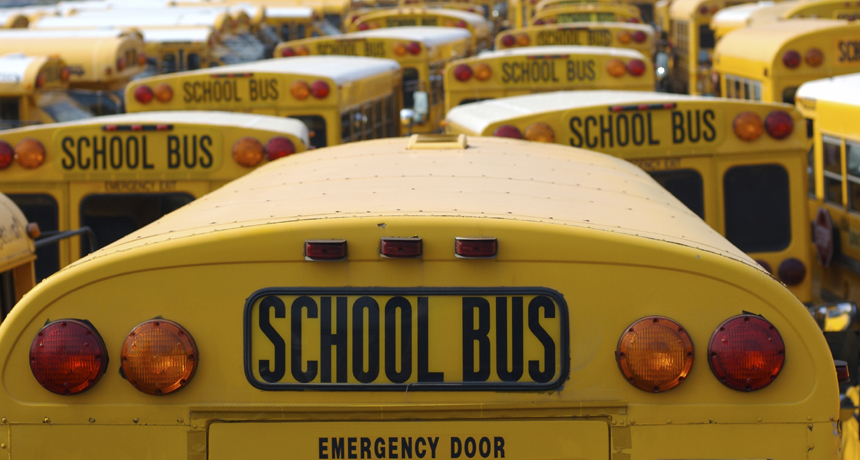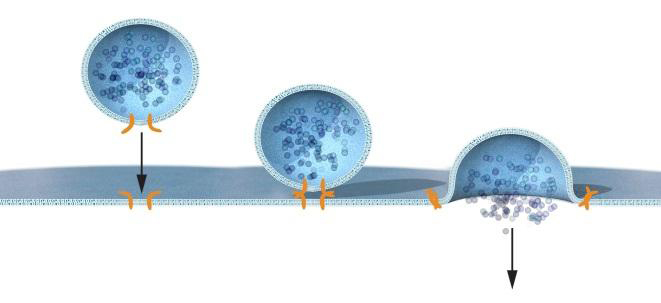Nobel goes for studying ‘school buses’ in cells
The three award winners studied the role of vesicles — bubble-like ‘buses’ — that move chemicals within cells or through their outer walls.

This year’s Nobel for physiology or medicine goes for work that showed how cells move chemicals around, both inside themselves and through their outer wall. They use bubbles that work a bit like buses. And if everything doesn’t go quite right, traffic jams can develop that keep those buses from delivering their occupants to the right place and on time.
PeskyMonkey/iStockphoto
Each year since 1901, the Royal Swedish Academy of Sciences issues one or more Nobel Prizes for biology. Sometimes the awards go to doctors or scientists who invent new drugs, vaccines, ways to do surgery or useful devices like the artificial heart. That becomes an award for medicine. Other times, like this year, it celebrates major achievements in physiology, which is the science of how cells and bigger structures in living organisms work.
On Oct. 7, the Nobel Prize in physiology or medicine went to Randy Schekman, James Rothman and Thomas Südhof for their work on cells. All three have been studying how cells move materials inside themselves and export chemical products outside of themselves. At a ceremony on Dec. 10, these scientists will receive medals and share a cash prize equal to slightly more than $1.24 million.
Cells stuff proteins, hormones and other important chemicals into bubbles called vesicles. When a cell wants to send a message to another cell or needs to build something inside itself, it ships a bubble with the right cargo off to where that material is needed.

The process is similar to getting on a bus in the morning, explains Juleen Zierath. She’s a physiologist at the Karolinska Institute in Stockholm, Sweden. She also chaired the committee that decided who should win this year’s Nobel Prize for biological work.
Imagine if the signs on all the busses disappeared, Zierath says. You wouldn’t know if the bus you got on would take you to school or if you’d end up downtown or somewhere in the boondocks. And you wouldn’t know how long the journey would take. The bubbles that act like buses inside cells depend on chemicals known as transport proteins, she says. Proteins are chemicals that do most of the work inside cells. Transport proteins tell the bubbles where to take their passengers and when to let them off
Shipping companies brag that they will deliver the packages that people send to each to other on time. But it is even more important that cells deliver things to the right place exactly when they are needed.
Those cellular deliveries shuttle the chemicals that serve as messages that brain cells use to talk to each other. Cells of the immune system send chemicals out to fight infections. Other cells release hormones that help the body know when to do a host of important tasks that keep your body alive and well. These range from growing and deciding you’re hungry to recognizing when it’s time to sleep.
“You cannot stop a process that is this fundamental,” says Edwin McCleskey, a scientist at the Howard Hughes Medical Institute. “If you mess with it, you die.”
In the 1960s and early 1970s, scientists watched through the microscope as bubbles zipped around inside cells. At the time, they couldn’t figure out how the cells knew where and when to send each bubble of chemicals.
The 2013 Nobel Prize winners discovered proteins that sort the packages and then deliver them to where they need to go.
What their work uncovered
Randy Schekman is a professor at the University of California, Berkeley. He wanted to know how cells secrete — or give off — chemicals like insulin. Insulin is a hormone that helps control how much energy the body uses. People with diabetes either don’t make enough insulin or don’t use it effectively.
Instead of studying how people ship insulin out of their cells, Schekman studied yeast. Yeast are single celled organisms that are used for such things as baking bread, brewing beer and making wine. Scientists like to work with yeast in the lab because they grow very quickly.
Although people and yeast don’t seem to have much in common, yeast cells and human cells have pretty much the same internal machinery. They also carry out most of the same basic chores.
Schekman got the idea that if he could break some of the proteins that ship the bubbles, it might cause a traffic jam inside their cell. He could then see where the pileups happened. That would tell him where the protein worked and give clues to what sort of transportation work it performed. So he and his colleagues made a collection of yeasts, each one with a different dinged-up protein. These busted proteins indeed caused traffic jams in different parts of the cell or in different ways. By figuring out what was behind each traffic jam, Schekman found 23 different proteins involved in exporting cargo out of the cells.
James Rothman works at Yale University in New Haven, Conn. He also was interested in the problem of busing cargo around cells, but took a different approach. Rothman broke open hamster cells and then put the parts in a test tube. The bubble-like vesicles moved in the test tube — unless he left out some proteins. Then the bubbles failed to move. By adding and subtracting different proteins, Rothman learned which ones moved cargo in the hamster’s cells. Those proteins carry out the same work in human cells.
Rothman and Schekman discovered that many of the proteins that move vesicles in hamster and human cells are the same ones that work in yeast. That discovery meant that this sort of traffic control is ancient, meaning it developed early in evolution. As a result, fungi, plant and animal cells all use the same machinery for the job.
Thomas Südhof works at Stanford University in Palo Alto, Calif. He probed how brain cells communicate with each other so swiftly. Brain cells chat with each other by releasing packages of chemicals called neurotransmitters. A brain cell has less than a millisecond — one thousandth of a second — to discharge a chemical message. This express delivery service makes it possible for the brain to work.
“Every school kid is able to appreciate fast biology,” says McCleskey. “Every movement they’re able to make, every sensation they’re able to feel is the result of fast biology.”
Südhof studied brain and nerve cells from mice to learn how that quick discharge works.
When calcium enters a cell, it causes a sort of protein clamp to release, he found. This allows the bubbles to rapidly fuse with the brain cell’s outer covering, called a membrane. As that fusion takes place, the bubbles dump their neurotransmitters outside the cell. That whispers their messages — brain chatter — to neighboring cells.
Good news comes early
The Nobel Prize committee makes its decision about who should win and then calls the winners. This happened mid-morning, Swedish time, but 4:30 a.m. for James Rothman. When asked how the committee’s phone call made him feel, Rothman said, “It made me feel awake and rather good.”
Schekman admits that scientists often think about the clever things they will say if they win the prize. But all of those things flew right out of his head when the committee called him at 1:30 a.m. “Oh, my god!” was all he could say as he danced around with his wife, he recalls.
Südhof was nearly the last to learn he’d won. The Nobel committee couldn’t reach him because he was driving to a small town in Spain to attend a scientific conference. His response, when he finally got the call: “I was honored beyond words. I was stunned and I was literally speechless.”
And winning a Nobel means even more perks for Schekman. His high school science teacher from Western High School in Anaheim, Calif., sent him an e-mail saying that Schekman had now pushed aside Tiger Woods as the school’s most famous graduate. And the chancellor at UC Berkeley quickly told Schekman that he now qualified for the university’s highest honor: a free parking space on campus for life.
POWER WORDS
cell membrane Separates the inside of a cell from the outside of it. Some particles are permitted to pass through the membrane.
diabetes A disease where the body either makes too little of the hormone insulin (known as type 1 disease) or ignores the presence of too much insulin when it is present (known as type 2 diabetes).
insulin A hormone produced in the pancreas (an organ that is part of the digestive system) that helps the body use glucose as fuel.
neurotransmitter A chemical substance that is released at the end of a nerve fiber. It transfers an impulse to another nerve, a muscle cell or some other structure.
physiology The branch of biology that deals with the everyday functions of living organisms and how their parts function.
proteins Compounds made from one or more long chains of amino acids. Proteins are an essential part of all living organisms. They form the basis of living cells, muscle and tissues; they also do the work inside of cells.Among well known stand-alone proteins: the hemoglobin in blood and the antibodies that attempt to fight infections.Medicines frequently work by latching onto proteins.
vesicles Tiny bubble-like structures inside cells. Vesicles are encased in membranes and carry cargoes of proteins or other chemicals a cell needs to do its many jobs.
yeast One-celled fungi that can ferment carbohydrates (like sugars), producing carbon dioxide and alcohol. They also play a pivotal role in making many baked products rise.







